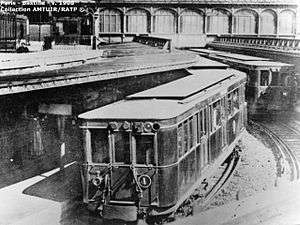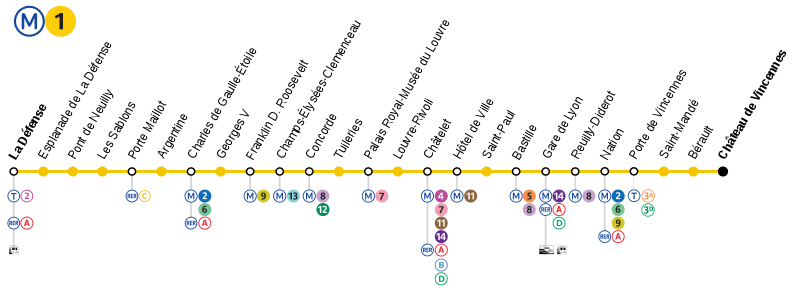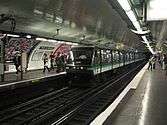Paris Métro Line 1
| Line 1 | |||||
|---|---|---|---|---|---|
 | |||||
| Overview | |||||
| System | Paris Métro | ||||
| Locale |
6 communes (Paris, Puteaux, Neuilly-Sur-Seine, Courbevoie, Saint-Mandé, Vincennes) | ||||
| Termini |
La Défense Château de Vincennes | ||||
| Connecting lines |
| ||||
| Stations | 25 | ||||
| Ridership |
207,000,000 (2010) (avg. per year) 1st/16 (2010) | ||||
| Operation | |||||
| Opened | 1900 | ||||
| Operator(s) | RATP | ||||
| Conduction system | Automated (SAET) | ||||
| Rolling stock |
MP 05 (52 trains as of May 27, 2015) | ||||
| Technical | |||||
| Line length | 16.6 km (10.3 mi) | ||||
| Track gauge | 1,435 mm (4 ft 8 1⁄2 in) | ||||
| |||||
Paris Métro Line 1 is one of the sixteen lines composing the Paris Métro (in Paris, France). It connects the La Défense – Grande Arche and Château de Vincennes stations. With a length of 16.5 km, it constitutes an important "East-West" transportation route for the City of Paris. Excluding RER (French: Réseau Express Régional) lines, it is the most utilised subway line on the network with 213 million travellers in 2008[1] or 725,000 people per day on average.[2]
Line 1 (as indicated by its name) was the first line to open, with its inaugural section opening in 1900. It is also the first line on the network to be converted from manually driven operation to fully automated operation. Conversion, which commenced in 2007 and was completed in 2011, included new rolling stock, the MP 05, and laying of platform edge doors in all stations. The first eight MP 05 trains (#s 501 through 508) went into passenger service on 3 November 2011,[3][4] allowing the accelerated transfer of the existing MP 89CC stock to line 4. The conversion allowed Line 1 to operate as the system's second fully automated line, after Line 14.
A transition to fully automated services was done without major interruption to passenger traffic. The new MP 05 rolling stock was able to operate efficiently alongside the manually-driven MP 89 CC rolling stock until there were enough MP 05 to no longer facilitate the need of the MP 89. Full automation was achieved for evening services in May 2012, with an increase to weekend services by August 2012. As of 15 December 2012 Line 1 is 100% automated with only a few MP 89 CC trains being used during rush hours when needed. The remaining 5 trains will remain stored on Line 1 near the Fontenay workshops until a new garage for Line 4 is opened south of the new Mairie de Montrouge station in February 2013.
History

In November 1898, Paris decided to undertake preliminary work of the metro network with the construction of the first line of the Parisian subway system. Work lasted twenty months under the leadership of engineer Fulgence Bienvenüe and was financed by the municipality of Paris. The line was divided into eight parts distributed between several companies. On 19 July 1900, the line was opened between Porte Maillot and Porte de Vincennes to connect the various sites of the World Fair. Only eight stations were finalized and opened with the inauguration; ten more were gradually opened between 6 August and 1 September 1900. The line followed the east-west monument axis in Paris. These eighteen stations were entirely built under the control of engineer Fulgence Bienvenüe, the majority of them 75 metres long and 4.10 metres wide. In March 1934, the first extension into the suburbs brought service to Château of Vincennes towards the east.
Chronology
- 19 July 1900: Inauguration of line 1 between Porte de Vincennes and Porte Maillot. Only 8 of the 18 planned stations were opened.
- 6 August and 1 September 1900: The other 10 stations of the line opened.
- 24 March 1934: The line was extended to the east from Porte de Vincennes to the castle of Vincennes.
- 15 November 1936: Porte Maillot station was rebuilt in order to allow a further extension of the line to the west.
- 29 April 1937: The line was extended to the west from Porte Maillot to Pont de Neuilly.
- 1963: The rails were converted in order to accommodate rubber-tyred trains (the MP 59). At the same time, stations were enlarged in order to accommodate 6-car trains instead of 5-car trains.
- 1 April 1992: The line was extended again to the west from Pont de Neuilly to La Défense business district.
- 1997: MP 89CC rolling stock was introduced, replacing the older MP 59 stock.
- 2007: Automation project commenced.
- 3 November 2011: Cascading of MP 89CC to MP 05 stock began, as the automation project (construction) was completed.
- May 2012: Full automation is achieved for evening services.
- July 2012: Full automation is achieved for weekend services.
- 15 December 2012: Full automation reaches 100% status, allowing the MP 89CC to no longer be needed on Line.
Rolling Stock
Line 1 has had five different types of rolling stock throughout the years (from fr:Ligne 1 du métro de Paris#Matériel roulant).
- M1 (Westinghouse): 1900 – 1921
- Sprague-Thomson: 1913 – 1964
- MP 59: 1963 – 1998
- MP 89CC: 1995 – December 2012
- MP 05: 2011 – present
Automation
With the success of Line 14, the RATP began to explore the possibility of automating existing lines on the system. The agency first focused on Line 1, since it is the busiest of all of the Paris subway lines, and also the line most frequented by tourists. Automation would not only allow for Paris to remain as a model for technological innovations in the railway industry but also would permit an increase in the number of lines in normal service when RATP workers are striking (from MP 05).
Work began in 2007 and was largely carried out without interrupting passenger traffic. Preliminary work involved electrical and signaling upgrades throughout the entire line. Work also commenced on converting the original Porte Maillot station (also known as "Espace Maillot") into a light maintenance facility for the MP 05 rolling stock. In 2009, work commenced on installing platform screen doors; with Bérault and Porte Maillot being the first stations to be equipped. Due to its curved platform, Bastille (in 2011) was among the last stations to be equipped. During this time, stations were intermittently closed to allow platforms to be leveled with the height of the train floors (from fr:Ligne 1 du métro de Paris).
Although most of the stations remain the same as they were prior to automation (with the exception of the platform screen doors), many stations like St. Paul, received brand new signage. Franklin D. Roosevelt received a complete overhaul from its post World War II facade to a more contemporary & modern look.
On November 3, 2011, the first eight trains of the new MP 05 rolling stock were put into service on Line 1. These trains were able to run efficiently alongside the MP 89 CC rolling stock until enough automated stock was available for passenger service. This cascading was achieved thanks to the SAET (French: Système d'automatisation de l'exploitation des trains) system, which is the first version of Siemens Transportation Systems' Trainguard MT CBTC. The arrival of the new stock allowed the RATP to accelerate transfer of the MP 89 from Line 1 to Line 4 at a rate of about 2 to 3 trains per month between November, 2011 and November, 2012. That rate increased to 4 trains per month during November and December, 2012.
Major milestones were reached in May and July, 2012 as full automation reached sufficient levels by which the MP 89 were no longer needed during late evenings and weekends respectively. For the Nuit Blanche during October, 2012, Line 1 also operated in full automation. The final milestone was reached on December 15, 2012, as full automation of Line 1 approached 100%, allowing the remaining MP 89 trains to be pulled from regular service after December 21, 2012. Due to a lack of storage space on Line 4, the remaining 6 to 7 MP 89 trains will remain stored on the Line 1 tracks near Fontenay until a new garage in the Montrouge area opens. That opening is tentatively set for February/March, 2013 and will coincide with the opening of the new Mairie de Montrouge station opening on Line 4.
Future
A western extension of Line 1 from La Défense station to the center of Nanterre is being considered. Another proposal being investigated would have a new station constructed at Fontenay – Rigollots, just before the line climbs to the surface to enter Fontenay shops, and then continue eastward to Val de Fontenay to connect with RER lines A and E.
Map and stations
This line has 25 stations.


Renamed stations
| Date | Old name | New name |
|---|---|---|
| 27 May 1920 | Alma station | George V |
| 5 May 1931 | Reuilly station | Reuilly-Diderot |
| 20 May 1931 | Champs-Élysées | Champs-Élysées – Clemenceau |
| 26 April 1937 | Tourelle | Tourelle – Saint-Mandé |
| 6 October 1942 | Marbeuf | Marbeuf – Rond-Point des Champs-Élysées |
| 30 October 1946 | Marbeuf – Rond-Point des Champs-Élysées | Franklin D. Roosevelt |
| 25 May 1948 | Obligado | Argentine |
| 1970 | Étoile | Charles-de-Gaulle – Étoile |
| 1989 | Palais Royal | Palais Royal – Musée du Louvre* |
| 1989 | Louvre | Louvre – Rivoli* |
| 1997 | Grande Arche de la Défense | La Défense |
| 26 July 2002 | Saint-Mandé – Tourelle | Saint-Mandé |
* The Louvre station renamings were made after the entrance to the museum was moved following construction of the Louvre Pyramid.
Tourism
Line 1 passes near several places of interest:
- La Défense high-rise business district, where the most prominent landmark is the Grande Arche.
- The Arc de Triomphe at Charles de Gaulle-Étoile. A 289 step staircase is open to the public and leads to the top of the Arch. There is also a museum on the top floor.
- L'Avenue des Champs-Élysées.
- The Place de la Concorde dominated by the Obelisk, Tuileries garden and Louvre museum.
- The Louvre station has copies of works of art from the museum and has historical information. The station's benches are made of glass and the Western portal has Roman-inspired arches along the platform edge.
- The Hôtel de Ville (Paris City Hall) and the Marais district.
- Bastille and the nearby Opera.
- Gare de Lyon train station.
- The Place de la Nation.
- The Bois de Vincennes (Vincennes Wood) and Paris Zoological Park (Vincennes Zoo).
- The Château de Vincennes. A medieval castle to the east of Paris.
Gallery
See also
References
- ↑ Le Parisien – Pourquoi la ligne 1 circule presque normalement, article du 16 novembre 2007.
- ↑ "RATP.fr : Ouverture du PCC de la ligne 1" (PDF). (638 KB), november 16, 2010
- ↑
- ↑ http://www.leparisien.fr/paris-75/les-premieres-rames-automatiques-roulent-sur-la-ligne-1-03-11-2011-1699463.php
External links
- (French) RATP official website
- (French) Metro-Pole website, dedicated to Paris public transports (unofficial)
| Paris Métro | Line 1 | |
|---|---|---|
| ||






